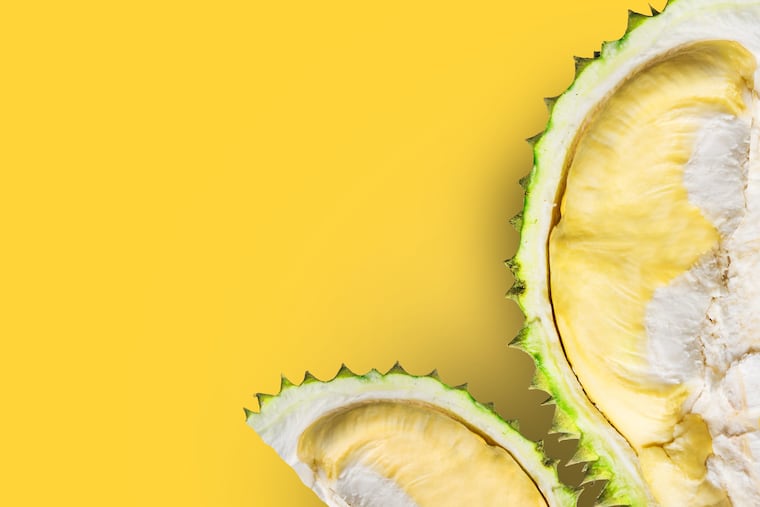This fruit smells terrible. A Philly chef wants to fix its bad rap.
Saté Kampar’s Ange Branca is on a mission to introduce Philadelphia to the joy of durian this fall—and she’s betting that tempoyak, a traditional Malaysian sambal, is the way to do it.

Saté Kampar’s Ange Branca is on a mission to introduce Philadelphia to the joy of durian this fall — and she’s betting that tempoyak, a traditional Malaysian sambal, is the way to do it.
Durian is a melon-sized tropical tree fruit with spiky, olive-green skin that’s native to Southeast Asia. It’s prized in many Asian cultures for the complex flavor and silky, custardlike texture of its butter-yellow flesh, but the smell can be so unpleasantly pungent that they’re banned on public transportation in many Asian countries. (There’s a tongue-in-cheek “No Durian” sign posted on the door of Saté Kampar’s restroom.) But with the addition of a little salt and a few days at room temperature for lactic acid bacteria to do their work, the aroma mellows considerably.
While durian is abundant in Branca’s native Malaysia at the end of the midsummer and midwinter growing seasons, she is preserving the fruit in the form of tempoyak to make this sambal available for use as a condiment and flavor-enhancer in her traditional Malaysian dishes year-round. On November 1, Branca is bringing tempoyak to the James Beard Taste America feast at the Fitler Club, serving it alongside tequila pickles as a prelude to a dinner from Michael Solomonov, Marc Vetri, and Miami chef Michelle Bernstein.
On its own, tempoyak might look like a batch of banana pudding gone wrong, but the texture is light and creamy, almost as though it’s been whipped. The flavor is bright, punchy, and multidimensional: fruity sweetness; rich umami; a pleasantly bracing tang that whiffs up through your nose; a nutty, allium-like afternote. Branca finishes it with a paste of shallots, garlic and Thai chilies to amp up the flavors and add a satisfying, persistent heat — giving the perfect accent to vegetables and herbs in ulam tempoyak, a vegetable dish on Saté Kampar’s menu right now.
But durian has a bad rap. Branca puts the blame for durian’s punchline status in much of the Western world on one man: Andrew Zimmern. In 2013, the Man vs. Food host tried durian on his show — and lost the battle.
“That’s part of why durian is misunderstood,” Branca said. “He’s the celebrity chef who hates durian the most … How can a fruit take him down? It’s ridiculous.”
Here in the States, Branca typically purchases frozen packs of Monthong durian, a mild, floral Thai variety, already shelled and de-seeded. When she can find it, she’ll sometimes buys whole frozen Musang King, a Malaysian type prized across Asia for its funk and complex flavor, from the Asian grocery store at Sixth and Washington (the fruit is too perishable to be shipped fresh). Spring Garden Market in Northern Liberties and H-Mart in Upper Darby also typically carry the frozen fruit.
“You get a lot of different profiles,” Branca said. “Every time you open a durian, it’s always a surprise. Part of the enjoyment is not knowing what you’re going to get.”
That’s how Branca remembers the fruit from her childhood in Kuala Lumpur. The Orang Asli, Malaysia’s indigenous people, would gather the abundant fruits from the forest and sell them at the edge of the forest. Her parents would drive out and purchase a big basket containing dozens of durians.
At home, Branca and her family would enjoy the best-tasting durians fresh and use the undesirable specimens for tempoyak. At Saté Kampar, the chef is spotlighting its flavor with her own take on ulam tempoyak. It’s her hope that she’ll win over diners who may be wary of trying durian by putting the ingredient in an approachable, hummus-like context.
Right now, the dish includes cherry tomatoes, sliced cucumbers, and carrot sticks alongside crisp rounds of green-skinned Kermit eggplant, tender okra pods, and tart roselle leaves, grown by VietLead’s Resilient Roots Community Farm in Camden. As the weather changes, the chef will rotate in a new set of seasonal veggies.
Branca also has plans to use tempoyak in an upcoming collaboration with Long Xiang, chef-owner at Old City Szechuan spot About Hotpot, this winter. He’ll serve her take on hotpot, based around a sizzling tempoyak-based broth, while she’ll add some of Xiang’s family recipes from Northeast China at her restaurant.
“When I taste [tempoyak], it’s all these flavor notes you would need in a dish or in a sauce, but you’re going to have to gather about a dozen ingredients to create this flavor note that’s in one fruit,” Branca says. “That’s why I’m so in love with durians.”